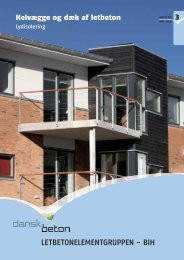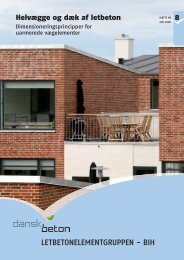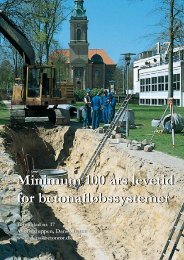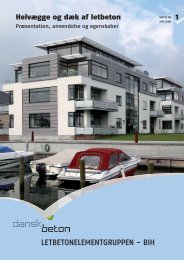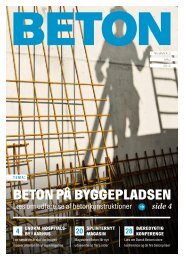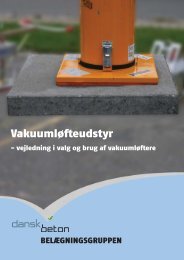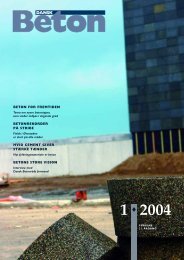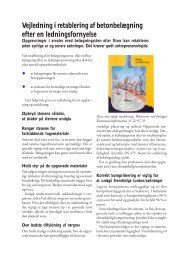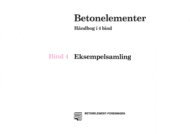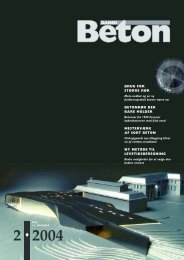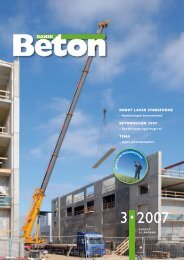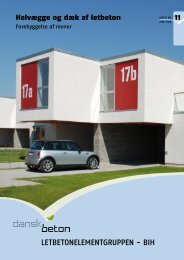Concrete Credentials: Sustainability
Concrete Credentials: Sustainability
Concrete Credentials: Sustainability
- No tags were found...
You also want an ePaper? Increase the reach of your titles
YUMPU automatically turns print PDFs into web optimized ePapers that Google loves.
CONCRETE CREDENTIALS: SUSTAINABILITYOVERVIEWThe concrete industry consists of nine sectors:cement, aggregates, admixtures, groundgranulated blast furnace slag (ggbs), fly ash,mortar, ready-mixed concrete, precastconcrete and steel reinforcement. In 2008,the UK concrete industry embarked on theimplementation of a sustainable constructionstrategy. This agreement to a number ofsustainability objectives included thecommitment to produce an annual report ofthe industry’s sustainability performance.The individual sectors and companies hadalready established initiatives and reportingstructures. The commitment to a comprehensiveindustry strategy has required further developmentof sector and company processes and this willcontinue as the framework is developed andrefined. In addition, the industry performanceindicators were developed to support the UKGovernment’s sustainable construction strategy.In March 2009 the industry published itsfirst report.In March 2010 the concrete industry publishedits second performance report. This signifiesanother key milestone for the concrete industry,leading other material sectors by publishingsustainability performance targets. With 12targets published and more in development,this reflects the industry’s commitment totransparency and continual improvement.For a full list of targets visitwww.sustainableconcrete.org.ukCover Image - Joseph Chamberlain School, Birmingham.This post-tensioned concrete-framed school achievedtop marks from the Prime Minister for inspiration indesign. <strong>Concrete</strong> provides environmental, social andeconomic advantages for school designAccurate information about the sustainablebenefits of concrete is essential to inform thecollaborative effort needed to make any newbuild or refurbishment/upgrade projectsustainable, both in construction andoperational use. The quick reference tableswithin this document present the performancebenefits of concrete in a format for designers toeasily interpret the sustainability credentials.The product and material data provided in thispublication is sourced from the concrete industry’ssecond report and specific sector reporting.RESPONSIBLE SOURCING ANDLOCAL PRODUCTIONThe concrete industry has already takensignificant steps to achieve and exceed the UKGovernment Sustainable Construction Strategytarget that at least 25% of construction materialsshould be supplied from suppliers withresponsible sourcing certification by 2012. Forthe latest information on what products havecertification visit www.greenbooklive.comThe concrete industry is the first industry tolink its sustainable construction strategy to theresponsible sourcing standard developed bythe Building Research Establishment (BRE), BES6001 - “Framework Standard for the ResponsibleSourcing of Construction Products”. The localnature of concrete’s production and the wellintegrated supply chain has been an advantagefor concrete companies to gain accreditation.Designers can now easily source accreditedmaterial and gain maximum credits insustainability assessment tools such as the Codefor Sustainable Homes and BREEAM.<strong>Concrete</strong> is the local material and this leads tosocial, economic and environmental benefits; forexample, local skills development, localemployment and local accountability forenvironmental impacts. Over 33,000 peopleare directly employed in the UK concreteindustry. The concrete industry is committed toengaging with and supporting localcommunities and 86% of relevant sites havecommunity liaison activities.The average delivery distance of ready-mixedconcrete to the construction site is just eightkilometres, and just over 150 kilometres forprecast concrete products.The average road delivery distance foraggregates is only 38 kilometres. 50 per cent ofready-mixed concrete plants are located at theaggregate extraction site helping to reduce theimpact of transportation.WASTE AND MATERIALEFFICIENCYThe concrete industry diverted over 5 milliontonnes of material from the waste stream andused them in place of primary materials. Wasteis used as a source of fuel and also used inconcrete manufacture. By-products from otherindustries, such as fly ash from power stations andggbs from the iron industry reduce demand onprimary materials and also reduce theembodied CO 2of concrete, when used asadditional cementitious material. For detailedestimates of the CO 2emissions associated withan ‘average’ tonne of concrete, suitable for use ina carbon calculator, which also include data forwater and steel reinforcing bar, visitwww.sustainableconcrete.org.ukResearch shows that virtually all the recycledaggregates in the waste stream are alreadybeing re-used, and have replaced around 25%of virgin aggregate use. This is the highest levelachieved amongst all European Countries.ENERGY AND CO 2The energy-intensive sectors in the industry havea well-established record of reducing carbonand greenhouse gas emissions. The cementsector has improved its Climate ChangeAgreement performance by 33.7% between1990 and 2008, exceeding the agreement target.The ground granulated blast furnace slag sectorhas achieved a 19% energy reduction between1999 and 2008.As well as the energy used in product manufactureand construction (embodied/embedded) themore significant energy use is in the operationof our homes and buildings. Residential buildingsalone are responsible for 27 per cent of UKCO 2emissions.The thermal performance properties of concreteas a construction material can provide considerablein-use (operational) energy savings over the lifetimeof a building. In housing for example, thisoperational energy saving can offset the slightlyhigher embodied CO 2associated with concreteand masonry homes within a decade of use. Tofind out more visit www.concretecentre.com
CONCRETE CREDENTIALS: SUSTAINABILITYTHE PERFORMANCE BENEFITS OF CONCRETEFIRE RESISTANCEEnvironmental<strong>Concrete</strong> does not burn and thereforeit reduces noxious emissions from afire, and wastage of materials.SocialThe resilience of concrete reducesdamage and limits the potential lossof livelihood or homes through a fire.During construction there is no riskto neighbours of the concrete framebeing a fire hazard.EconomicRegulations require safe evacuationof occupants but not property safety.<strong>Concrete</strong> structures comply with lifesafety regulation but can also resistfire to enable cost-effective repair andre-use.THERMAL MASSEnvironmental<strong>Concrete</strong>’s thermal mass allows it tobe used to reduce heating andcooling energy of buildings.SocialThe thermal mass of concrete canbe used to reduce overheating ina building. Occupants affected bypublic funding and CO 2targets, insocial housing and schools, are at riskof overheating if energy use cannotbe reduced by no cost options.EconomicUsing the thermal mass of concretewill lower running costs of a building.It will also reduce the plantneeded on site, leading to reducedmaintenance costs.DURABILITYEnvironmentalDue to the long life of all concretestructures, material impacts on theenvironment are kept to an absoluteminimum.SocialThe durability of concrete structuresmeans that, once built, they arerarely out of use for maintenanceand hence have minimum socialdisruption.Economic<strong>Concrete</strong> is a very stable and durablematerial with an extremely long life.As a result, maintenance costs areminimal for concrete structures.ACOUSTIC ISOLATION PERFORMANCEEnvironmental<strong>Concrete</strong> has good acoustic performanceand there is less reliance on finishes andmaterials which have a short lifespan.Hence less material is used and potentialwaste is avoided.Social<strong>Concrete</strong>’s mass absorbs sound,ensuring quality of life, particularly inhigh density living, where dwellingsare prone to acoustic break-in.Economic<strong>Concrete</strong> walls and floors providerequired acoustic separation withminimum finishes, hence minimumcost and maintenance.ROBUSTNESS/SECURITYEnvironmental<strong>Concrete</strong> structures are robust,reducing risk of damage to finishes,hence less use of materials throughthe whole life-cycle of structures.SocialSolid concrete party walls providesafe, secure buildings. Preventionof intruders helps to build safercommunities.Economic<strong>Concrete</strong> structures, particularly iffinishes are minimised, will suffer lessdamage and cost less to repair andmaintain.FLOOD RESILIENCEEnvironmentalThe flood resilience of concretemeans it retains structural integrity,resulting in minimum wastage ofmaterials following a flood event.SocialA concrete structure will resist waterpenetration, keeping inconvenienceand disruption to business,homeowners and the community toa minimum following a flood event.EconomicDowntime of businesses, homesand essential community services, isminimised if flooded buildings areconstructed in concrete.




